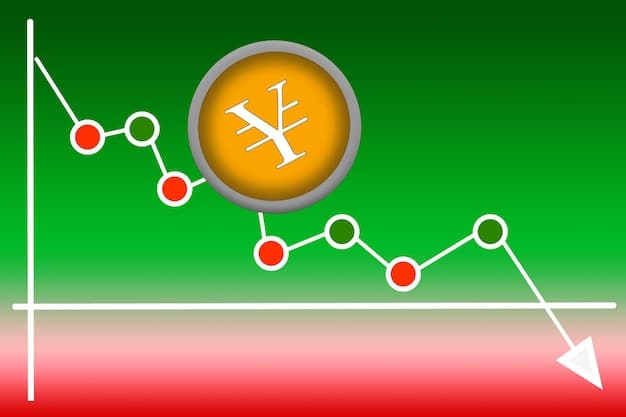Passive Income Revolution: Staking Crypto for 2025 Rewards

Staking cryptocurrency for rewards is poised to revolutionize passive income strategies in 2025, offering individuals a way to earn returns by participating in the validation process of blockchain networks, while contributing to network security and efficiency.
The world of passive income is constantly evolving, and in 2025, one strategy stands out: Passive Income Revolution: Staking Cryptocurrency for Rewards in 2025. This approach involves locking up your cryptocurrency holdings to support a blockchain network and earning rewards in return.
Understanding Cryptocurrency Staking
Cryptocurrency staking has become a popular method for earning passive income. It allows individuals to participate in the operation of a blockchain network and earn rewards for their contribution.
What is Staking?
Staking is the process of holding cryptocurrency in a wallet to support the operations of a blockchain network. By staking, you’re essentially locking up your coins to help validate transactions and maintain the network’s security.
How Does Staking Work?
When you stake your cryptocurrency, you become a validator on the network. Validators are responsible for verifying transactions and adding new blocks to the blockchain. In return for their services, they earn rewards in the form of additional cryptocurrency.
- 💰 Staking involves locking up cryptocurrency to support a blockchain network.
- 🔒 Validators verify transactions and add new blocks to the blockchain.
- 💸 Stakers earn rewards for their contribution to network security.

Staking represents a significant shift from traditional finance, offering a more accessible and democratic way to earn returns. As the cryptocurrency landscape continues to evolve, staking will likely play an even more prominent role in the future of finance.
Benefits of Staking Cryptocurrency
Staking cryptocurrency offers several advantages, making it an attractive option for those seeking passive income. These benefits range from earning rewards to contributing to the security of the blockchain network.
Earning Passive Income
One of the primary benefits of staking is the ability to earn passive income. By staking your cryptocurrency, you can receive rewards in the form of additional coins.
Contributing to Network Security
Staking also helps to secure the blockchain network. By participating in the validation process, you’re contributing to the overall integrity and stability of the network.
- 💡 Earning passive income is a major incentive for staking.
- ✅ Staking enhances the security and stability of the blockchain network.
- 📈 Staking rewards can potentially outperform traditional investment returns.
The combination of earning potential and contributing to a secure network makes staking an appealing option for many cryptocurrency holders. With the right strategy, staking can be a valuable component of a diversified investment portfolio.
Risks Associated with Staking
While staking cryptocurrency offers numerous benefits, it’s essential to be aware of the potential risks involved. Understanding these risks can help you make informed decisions and protect your investments.
Price Volatility
The value of cryptocurrencies can fluctuate significantly, which can impact the overall return on your staked assets. If the price of the cryptocurrency drops, the value of your rewards may not offset the losses.
Lock-Up Periods
Many staking platforms require you to lock up your coins for a specific period. During this time, you may not be able to access or sell your assets, which can be problematic if you need the funds unexpectedly.
- ⚠️ Price volatility can erode staking profits.
- ⏳ Lock-up periods restrict access to staked assets.
- 🛡️ Staking can involve technical complexities and security risks.

Despite these risks, staking can still be a worthwhile investment if approached with caution. Diversifying your portfolio, understanding the lock-up periods, and staying informed about market trends can help mitigate these risks.
Choosing the Right Cryptocurrency for Staking
Selecting the right cryptocurrency for staking is crucial for maximizing your returns and minimizing risks. Several factors should be considered when making your decision.
Market Capitalization
Opting for cryptocurrencies with high market capitalization can provide more stability and liquidity. Larger cryptocurrencies are generally less volatile and have a more established ecosystem.
Staking Rewards
Compare the staking rewards offered by different cryptocurrencies. Higher rewards may seem attractive, but they often come with greater risks.
- ⚖️ Market capitalization indicates stability and liquidity.
- 🎁 Staking rewards vary significantly across different cryptocurrencies.
- ⚙️ Network consensus mechanisms impact staking requirements and returns.
By carefully evaluating these factors, you can make a more informed decision and choose a cryptocurrency that aligns with your investment goals and risk tolerance. Researching and staying informed is key to successful staking.
How to Start Staking Cryptocurrency
Getting started with staking cryptocurrency is a straightforward process, but it requires careful planning and execution. Here’s a step-by-step guide to help you begin your staking journey.
Selecting a Staking Platform
Choose a reputable staking platform or wallet that supports the cryptocurrency you want to stake. Popular options include centralized exchanges like Binance and Coinbase, as well as decentralized wallets like Trust Wallet and MetaMask.
Setting Up Your Wallet
Create a secure wallet and transfer your cryptocurrency to it. Make sure to back up your wallet’s private keys and store them in a safe place.
- 📱 Choose a secure and reliable staking platform or wallet.
- 🔐 Set up a secure wallet and back up your private keys.
- Stake your cryptocurrency and monitor your rewards regularly.
With these steps, you can begin staking cryptocurrency and start earning passive income. Remember to stay informed, monitor your investments, and adjust your strategy as needed to maximize your returns.
The Future of Cryptocurrency Staking in 2025
As we look ahead to 2025, cryptocurrency staking is expected to continue its growth and evolution. Several trends and developments are likely to shape the future of staking.
Increased Adoption
With the growing popularity of cryptocurrencies, more individuals and institutions are expected to adopt staking as a means of earning passive income.
Technological Advancements
Innovations in blockchain technology will likely lead to more efficient and user-friendly staking platforms. This could include improvements in consensus mechanisms, smart contracts, and security protocols.
- 🌍 Increased adoption will drive the growth of staking.
- 🚀 Technological advancements will enhance staking platforms.
- 🏛️ Regulatory clarity will foster wider acceptance of staking.
The future of cryptocurrency staking in 2025 looks promising. With increased adoption, technological advancements, and regulatory clarity, staking is poised to become an even more significant part of the cryptocurrency ecosystem.
| Key Point | Brief Description |
|---|---|
| 💰 Understanding Staking | Staking involves holding crypto to support blockchain operations and earn rewards. |
| ✅ Benefits of Staking | Staking provides passive income, contributes to network security, and offers potential for high returns. |
| ⚠️ Risks of Staking | Risks include price volatility, lock-up periods, and the potential for technical complexities. |
| 💡 Future of Staking | The future of staking is promising with increased adoption, technological advancements, and regulatory clarity. |
Frequently Asked Questions
▼
Proof of Stake is a consensus mechanism where validators are chosen based on the amount of cryptocurrency they hold and are willing to “stake.” It’s a more energy-efficient alternative to Proof of Work.
▼
Consider factors like security, user-friendliness, supported cryptocurrencies, staking rewards, and lock-up periods. Research and read reviews to find a reputable platform that suits your needs.
▼
Staking rewards are typically considered taxable income. Consult a tax professional to understand the specific tax implications in your jurisdiction and ensure compliance with local regulations.
▼
Yes, there are risks. Price volatility can reduce the value of your staked assets, and some platforms may have security vulnerabilities. Choose reputable platforms and diversify your portfolio to mitigate risks.
▼
Diversify your portfolio, choose reputable staking platforms, understand the lock-up periods, stay informed about market trends, and secure your wallet with strong passwords and two-factor authentication.
Conclusion
As we look to 2025, the passive income revolution: staking cryptocurrency for rewards in 2025 presents a compelling opportunity for individuals seeking to grow their wealth. By understanding the benefits, risks, and best practices associated with staking, you can position yourself to take advantage of this evolving financial landscape.





